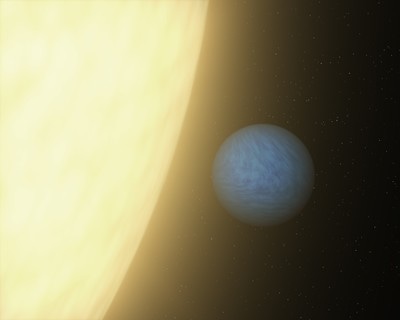May 10 2019
Planetary systems considerably different from our solar system are distributed throughout the galaxy. The planet closest to the Sun in the solar system—Mercury, with an orbit of 88 days—is also the smallest.
 An artist’s concept of super-Earth planet 55 Cancri e, which races around its host star once every 18 hours. New research led by Penn State astronomers improves our understanding of how large super-Earth planets with small, quick orbits form. (Image credit: NASA/JPL-Caltech)
An artist’s concept of super-Earth planet 55 Cancri e, which races around its host star once every 18 hours. New research led by Penn State astronomers improves our understanding of how large super-Earth planets with small, quick orbits form. (Image credit: NASA/JPL-Caltech)
However, NASA’s Kepler spacecraft has found out thousands of systems filled with massive planets—known as super-Earths—zipping around their host star in extremely small orbits multiple times every 10 days. At present, scientists could have achieved better insights into the formation of such planets.
A group of astronomers led by the Penn State discovered that when planets are formed out of the disorderly swirl of gravitational, hydrodynamic—or drag—and magnetic forces as well as collisions inside the dusty, gaseous protoplanetary disk surrounding a star, as a planetary system starts to form, the orbits of these planets ultimately get in synch, making them to slide—follow the leader-style—toward the star.
The computer simulations developed by the researchers lead to planetary systems with characteristics that are synchronous with those of real planetary systems detected by the Kepler space telescope of solar systems. Observations and simulations reveal large, rocky super-Earths that orbit very close to their host stars, stated Daniel Carrera, assistant research professor of astronomy at Penn State’s Eberly College of Science.
According to Carrera, the simulation is an effort toward gaining insights into why super-Earths assemble very close to their host stars. The simulations could also make it clear why super-Earths are usually located very close to their host star at which point there does not appear sufficient solid material in the protoplanetary disk to form a planet, let alone a big planet, said the researchers, who have described the study outcomes in the Monthly Notices of the Royal Astronomical Society.
When stars are very young, they are surrounded by a disc that is mostly gas with some dust—and that dust grows into the planets, like the earth and these super-Earths. But the particular puzzle for us is that this disc doesn’t go the all way to the star—there’s a cavity there. And yet we see these planets closer to the star than the edge of that disc.
Daniel Carrera, Assistant Research Professor of Astronomy, Eberly College of Science, Penn State
The computer simulation of the astronomers reveals that as time passes, the gravitational forces of the planets and disk lock the planets into synchronized orbits—resonance—with each other. Then, the planets start migrating in harmony, with some of the planets traveling closer to the disk’s edge. The combination of the gas disk that has an impact on the outer planets and the gravitational interactions between the inner and outer planets can continuously push the inner planets very close to the star, even internal to the disk’s edge.
With the first discoveries of Jupiter-size exoplanets orbiting close to their host star, astronomers were inspired to develop multiple models for how such planets could form, including chaotic interactions in multiple planet systems, tidal effects and migration through the gas disk. However, these models did not predict the more recent discoveries of super-Earth-size planets orbiting so close to their host star. Some astronomers had suggested that such planets must have formed very near their current locations. Our work is important because it demonstrates how short-period super-Earth-size planets could have formed and migrated to their current locations thanks to the complex interactions of multiple planet systems.
Eric Ford, Professor of Astronomy and Astrophysics, Director of Center for Exoplanets and Habitable Worlds, Penn State
Ford is also the Institute for CyberScience (ICS) faculty co-hire. According to Carrera, more efforts are needed to confirm that the theory is accurate.
“We’ve shown that it’s possible for planets to get that close to a star in this simulation, but it doesn’t mean that it’s the only way that the universe chose to make them,” stated Carrera. “Someone might come up with a different idea of a way to get the planets that close to a star. And, so, the next step is to test the idea, revise it, make predictions that you can test against observations.”
Future studies might also investigate the reason for the difference between our super-Earthless solar system and most other solar systems, added Carrera.
Super-Earths in very close orbits are by far the most common type of exoplanet that we observe, and yet they don’t exist in our own solar system and that makes us wonder why.
Daniel Carrera, Assistant Research Professor of Astronomy, Eberly College of Science, Penn State
The researchers stated that the best-reported predictions propose that nearly 30% of solar-like stars have certain planets close to the host star compared to the distance of the Earth from the Sun. However, they report that additional planets could be left unnoticed, specifically small planets located far from their star.
Andre Izidoro, researcher from Sao Paulo State University—UNESP, collaborated with Carrera and Ford on the research, which was made possible by collaborations formed as part of NASA’s Nexus for Exoplanet Systems Science.
Computations for this study were conducted on the Penn State’s Institute for CyberScience Advanced CyberInfrastructure (ICS-ACI) and the CyberLAMP computer cluster. This study was supported by the National Science Foundation, NASA, and Penn State’s Center for Exoplanets and Habitable Worlds.
How Do Super-Earths Cuddle So Close to Stars
Video credit: Penn State